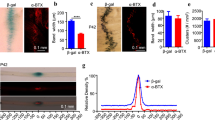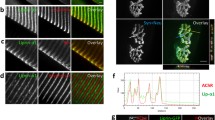Abstract
ATP is co-stored and co-released with acetylcholine (ACh) at the pre-synaptic vesicles in vertebrate neuromuscular junction (nmj). Several lines of studies demonstrated that binding of ATP to its corresponding P2Y1 and P2Y2 receptors in the muscle regulated post-synaptic gene expressions. To further support the notion that P2Y receptors are playing indispensable role in formation of post-synaptic specifications at the nmj, the knock-out mice of P2Y1 receptor (P2Y1R -/-) were employed here for analyses. In P2Y1R -/- mice, the expression of P2Y2 receptor in muscle was reduced by over 50 %, as compared to P2Y1R +/+ mice. In parallel, the expression of acetylcholinesterase (AChE) in muscle was markedly decreased. In the analysis of the expression of anchoring subunits of AChE in P2Y1R -/- mice, the proline-rich membrane anchor (PRiMA) subunit was reduced by 60 %; while the collagen tail (ColQ) subunit was reduced by 50 %. AChE molecular forms in the muscle were not changed, except the amount of enzyme was reduced. Immuno-staining of P2Y1R -/- mice nmj, both AChE and AChR were still co-localized at the nmj, and the staining was diminished. Taken together our data demonstrated that P2Y1 receptor regulated the nmj gene expression.




Similar content being viewed by others
Abbreviations
- ACh:
-
Acetylcholine
- nmj:
-
Neuromuscular junction
- AChE:
-
Acetylcholinesterase
- PRiMA:
-
Proline-rich membrane anchor
- ColQ:
-
Collagen tail
- G4 :
-
Tetrameric globular form
- A12 :
-
Asymmetric form
- TMR-BuTX:
-
Tetramethylrhodamine-conjugated α-bungarotoxin
References
Arthur DB, Akassoglou K, Insel PA (2005) P2Y2 receptor activates nerve growth factor/TrkA signaling to enhance neuronal differentiation. Proc Natl Acad Sci U S A 102:19138–19143
Chen VP, Choi RCY, Chan WKB, Leung KW, Guo AJY, Chan GKL, Luk WKW, Tsim KWK (2011) The assembly of proline-rich membrane anchor (PRiMA)-linked acetylcholinesterase enzyme glycosylation is required for enzymatic activity but not for oligomerization. J Biol Chem 286:32948–32961
Choi RC, Yung LY, Dong TT, Wan DC, Wong YH, Tsim KWK (1998) The calcitonin gene-related peptide-induced acetylcholinesterase synthesis in cultured chick myotubes is mediated by cyclic AMP. J Neurochem 71:152–160
Choi RC, Man ML, Ling KK, Ip NY, Simon J, Barnard EA, Tsim KWK (2001) Expression of the P2Y1 nucleotide receptor in chick muscle: its functional role in the regulation of acetylcholinesterase and acetylcholine receptor. J Neurosci 21:9224–9234
Choi RC, Siow NL, Cheng AW, Ling KK, Tung EK, Simon J, Barnard EA, Tsim KWK (2003) ATP acts via P2Y1 receptors to stimulate acetylcholinesterase and acetylcholine receptor expression: transduction and transcription control. J Neurosci 23:4445–4456
Choi RC, Simon J, Tsim KW, Barnard EA (2008) Constitutive and agonist-induced dimerizations of the P2Y1 receptor: relationship to internalization and scaffolding. J Biol Chem 283:11050–11063
Choi RC, Chu GK, Siow NL, Yung AW, Yung LY, Lee PS, Lo CC, Simon J, Dong TT, Barnard EA, Tsim KWK (2013) Activation of UTP-sensitive P2Y2 receptor induces the expression of cholinergic genes in cultured cortical neurons: a signaling cascade triggered by Ca2+ mobilization and extracellular regulated kinase phosphorylation. Mol Pharmacol 84:50–61
Ellman GL, Courtney KD, Andres V Jr, Feather-Stone RM (1961) A new and rapid colorimetric determination of acetylcholinesterase activity. Biochem Pharmacol 7:88–95
Fabre JE, Nguyen MT, Latour A, Keifer JA, Audoly LP, Coffman TM, Koller BH (1999) Decreased platelet aggregation, increased bleeding time and resistance to thromboembolism in P2Y1-deficient mice. Nat Med 5:1199–1202
Franke H, Illes P (2014) Nucleotide signaling in astrogliosis. Neurosci Lett 565:14–22
Jacob PF, Vaz SH, Ribeiro JA, Sebastiao AM (2014) P2Y1 receptor inhibits GABA transport through a calcium signaling-dependent mechanism in rat cortical astrocytes. Glia 62:1211–1226
Léon C, Hechler B, Freund M, Eckly A, Vial C, Ohlmann P, Dierich A, LeMeur M, Cazenave JP, Gachet C (1999) Defective platelet aggregation and increased resistance to thrombosis in purinergic P2Y1 receptor–null mice. J Clin Invest 104:1731–1737
Noguchi Y, Shinozaki Y, Fujishita K, Shibata K, Imura Y, Morizawa Y, Gachet C, Koizumi S (2013) Astrocytes protect neurons against methylmercury via ATP/P2Y(1) receptor-mediated pathways in astrocytes. PloS One 8
Rieg T, Bundey RA, Chen Y, Deschenes G, Junger W, Insel PA, Vallon V (2007) Mice lacking P2Y2 receptors have salt-resistant hypertension and facilitated renal Na+ and water reabsorption. FASEB J 21:3717–3726
Siow NL, Choi RCY, Xie HQ, Kong LW, Chu GKY, Chan GKL, Simon J, Barnard EA, Tsim KWK (2010) ATP induces synaptic gene expressions in cortical neurons: transduction and transcription control via P2Y1 receptors. Mol Pharmacol 78:1059–1071
Tsim KW, Barnard EA (2002) The signaling pathways mediated by P2Y nucleotide receptors in the formation and maintenance of the skeletal neuromuscular junction. Neurosignals 11:58–64
Tung EK, Choi RC, Siow NL, Jiang JX, Ling KK, Simon J, Barnard EA, Tsim KWK (2004) P2Y2 receptor activation regulates the expression of acetylcholinesterase and acetylcholine receptor genes at vertebrate neuromuscular junctions. Mol Pharmacol 66:794–806
Xie HQ, Choi RC, Leung KW, Siow NL, Kong LW, Lau FT, Peng HB, Tsim KWK (2007) Regulation of a transcript encoding the proline-rich membrane anchor of globular muscle acetylcholinesterase. The suppressive roles of myogenesis and innervating nerves. J Biol Chem 282:11765–11775
Yu W, Sun X, Robson SC, Hill WG (2014) ADP-induced bladder contractility is mediated by P2Y12 receptor and temporally regulated by ectonucleotidases and adenosine signaling. FASEB J 28:5288–5298
Yuan W, Wang Z, Li J, Li D, Liu D, Bai G, Walsh MP, Gui Y, Zheng XL (2013) Uridine adenosine tetraphosphate induces contraction of circular and longitudinal gastric smooth muscle by distinct signaling pathways. IUBMB Life 65:623–632
Acknowledgments
This research was supported by Hong Kong Research Grants Council Theme-based Research Scheme (T13-607/12R), GRF (661110, 662911, 660411, 663012, 662713), TUYF12SC02, TUYF12SC03, TUYF15SC01, The Hong Kong Jockey Club Charities Trust and Foundation of The Awareness of Nature (TAON12SC01) to Tsim.
Author information
Authors and Affiliations
Corresponding author
Rights and permissions
About this article
Cite this article
Xu, M.L., Bi, C.W., Cheng, L.K. et al. Reduced Expression of P2Y2 Receptor and Acetylcholinesterase at Neuromuscular Junction of P2Y1 Receptor Knock-out Mice. J Mol Neurosci 57, 446–451 (2015). https://doi.org/10.1007/s12031-015-0591-9
Received:
Accepted:
Published:
Issue Date:
DOI: https://doi.org/10.1007/s12031-015-0591-9




